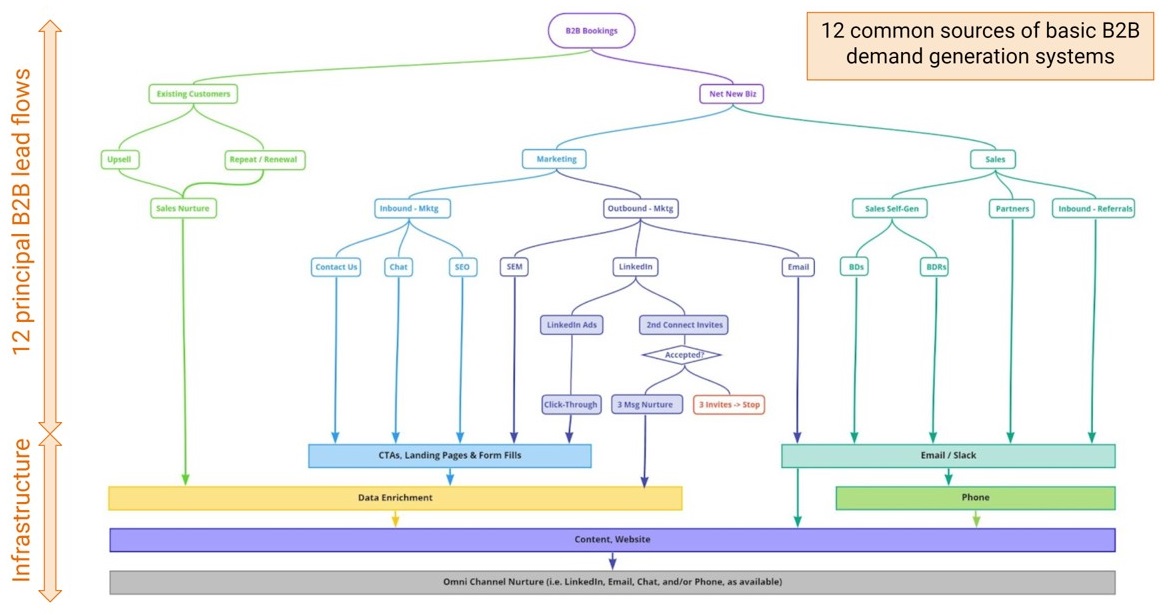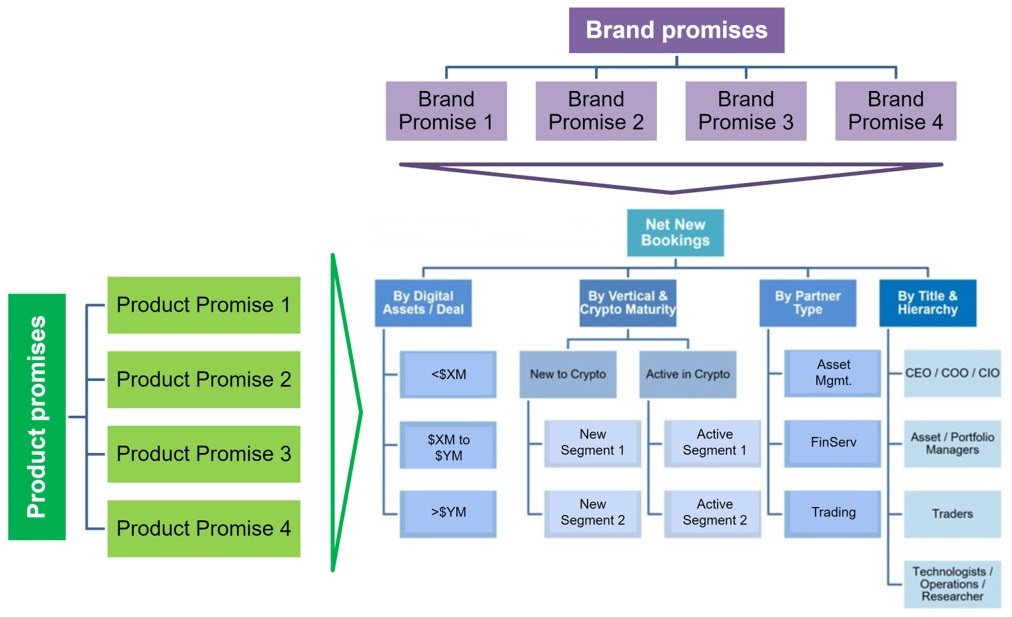Verticalized Messaging at Scale – Key to Effective Digital Lead Generation
There’s a story that small- to mid-sized startup CEOs love to tell about the early days of their business: The story of the CEO, alone with nothing but a laptop and a phone, dialing lead after lead after lead until, finally, enough business is inked for the company to start growing legs. Chances are you’ve worked for – or perhaps even been – that CEO.
The idea of going from zero leads to closed-won with nothing but a phone – and actually scaling a startup that way – is central to the lore of the tenacious pipeline building and to “if I could do that then, imagine what we can do now” pep talks everywhere. The problem? It’s rapidly becoming obsolete. Unless you price your offering at upward of around $200K per year, hiring live salespeople to find and close deals is simply unaffordable. Scaling a startup simply doesn’t work that way anymore, especially cloud software products whose average deal prices don’t economically support more then short tele-sales calls, at best.
Let’s talk about why that is, and why, today, success for growth-minded startup CXOs now hinges around one key objective: building an automated lead generation outreach system with verticalized messaging – and executing it at scale.
COVID changes the calculus on scaling startups
A few years ago, if you asked a startup sales rep what their highest-return lead gen methods were, two likely answers would have been:
- Lone-wolf prospecting culminating in picking up the phone for a smile-and-dial
- Hitting the conference circuit and engaging face-to-face
Then, in 2020…well, you know what happened. “Post-COVID New Normal” discussions are nothing new, but the pandemic’s impact on startup lead gen was so massive we can’t ignore it here. In February of 2020, conferences were a blast, and a wellspring of leads; by April, they’d been slapped with the much-maligned label of “superspreader event.” And with everyone working from home, business-appropriate phone numbers aren’t always available, making cold-calling even more of an uphill battle than it already was. In the cloud software space, all of this converged with a downward trend in price points, which have now gotten so low that one-prospect-at-a-time cold calling no longer scales profitably.
In the aftermath of this shift, the B2B customer journey has migrated almost entirely to the internet – and it will probably stay there regardless of the virology outlook going forward. After all, following the customer journey is much faster and more efficient when it happens online. For one thing, it can be automated; for another, without the time, money, and effort required to host and travel to conferences, it’s much cheaper and less intensive. We’ve talked to several CROs who say their days on the road are over, as they’ve become so much more productive closing business by digital means.
This represents a fundamental change in the way startups will scale from here on out, and there will certainly be some growing pains (more on that in a moment). But it’s not necessarily as daunting as it sounds. Yes, the internet is a big place – but when it comes to B2B lead generation, the good news is that a plethora of on- and offline lead sources converge on only a few relevant online touchpoints – and it’s at these key touchpoints where most B2B customer journeys will either start or end:
- Landing pages fed by SEO and nurture tracks
- LinkedIn ads, connection requests, and / or InMails
- Cold and nurture emails
- Paid and/or organic search results

Figure 1 is a detailed breakdown of most common B2B lead sources to be leveraged in the company’s verticalized messaging, with all ending up in the same handful of digital channels (more below).
With just about all B2B traffic funneling into this handful of online channels, it’s not too hard for startups to make their digital lead generation efforts both effective and efficient. Which brings us to…
Verticalized messaging, 2022 style
Verticalized messaging is, of course, not a new concept – but the way companies typically approach it has two major flaws that won’t stand in the fully digital post-COVID era. First, its deployment often relies on live, initial contact, which isn’t viable anymore, especially for lower-priced offerings. Second, companies too often treat it as an afterthought – marketing teams might draw up some rough notes about how to message to different verticals, but they often don’t take the time to build out a meticulous verticalized messaging framework in advance.
With digital marketing and selling, starting a customer’s journey without tuning your messaging to their precise needs will lead to lower click-through and conversion rates and thus a lower volume of good quality leads coming off the Internet. If you move forward without a scalable plan in place to verticalize your messaging, you’ll end up underwater. But if you take the time to build a robust plan up front, you’ll start scaling in no time.
So why is verticalized messaging so pivotal today? It’s really quite simple: In a fully online lead-gen paradigm, a one-size-fits-all approach to messaging will not work. In the pre-COVID days, back when it was easy to phone a lead directly or chat one-on-one at a conference, there was no need for the messaging deployed in those conversations to be particularly flexible. The audience was n-of-1 – as long as you spoke to the needs of the person you were talking to, you’d be alright. And a good sales person could work that out on the fly.
Today, lead generation is no longer a one-on-one conversation. It’s search engine ads, LinkedIn ads or invites, email blasts, and other digital channels – all seen by hundreds or thousands of people. That larger audience will consist of diverse segments of buyer personas, and you’ll need to have the tools, assets, and mechanisms in place to speak to all of them – with specific messaging and value propositions that relate to them. To successfully scale pipelines and grow startups today, then, you’ll need to automate the verticalization of your messaging.
Here’s what a high-level action plan for verticalized messaging should look like:
- Build out value props and precision segmentation
Your first steps are to establish your value propositions, break your ideal customer profiles (ICPs) into precise segments, and map them all together. If you’re a healthcare software company, for example, which ICPs will resonate with your product’s ability to ensure regulatory compliance? Which will instead resonate with other benefits like accelerated data entry?
Pro tip: A 2D grid, with value props on the X axis and ICPs on the Y axis, is a great way to lay this out visually. - Develop and incorporate assets
Now that you’ve mapped your value props to your ICPs, it’s time to identify the channels you’ll leverage to deploy the right messages to the right people. The biggest lift here is up-front content production. How many landing pages will you need to produce? How many LinkedIn ads? Your 2D grid is now 3D, with each cell identifying a verticalized asset that incorporates the three considerations of lead channel, value prop, and ICP: A LinkedIn ad focused on regulatory benefits for Compliance personas, a landing page focused on accelerated data entry for end users, and so on. - Execute at scale
You now have everything you need to deploy your messaging in a robust, verticalized, and automated way – to a much larger audience than your sales reps would ever have been able to reach via lone-wolf prospecting. Once your message is out in the world, don’t forget about essential post-launch tasks like campaign management and performance metrics, both of which are essential to making optimizations based on early results.
There’s no denying it: This will take some planning and preparatory work. But it will also empower you to maximize both the effectiveness and the efficiency of your messaging, leaving little doubt that the investment will pay off. As Anna Courval, V.P. of Marketing at Afterburner, puts it, building a scalable and automated verticalized messaging plan “has been a game-changer for us. It’s allowed us to find a clear path to our revenue goals for the year.”
Modern verticalized messaging in action
How this plays out in real-world scenarios will, of course, vary – and may get a bit more complicated depending on the needs and realities of the company in question. Below is an example of how scalable and automated verticalized messaging played out for a startup in the crypto space. As with any company operating in a still-burgeoning space, views of their business ranged from enthusiasm to skepticism to confusion. This made for a wide array of buyer personas, requiring the company to develop a wide array of tailored messages to kick off the customer journey.
Step 1
The company started by mapping out the various buyer personas they’d target (Figure 1). They took a hierarchical approach, first breaking down their market into Existing Customers and Net-New Bookings, then further segmenting the buyers within each category. Within the Existing Customers category, the segmentation was pretty simple – but for Net-New Bookings, the company leveraged demographic, firmographic, and psychographic attributes to create much more detailed and precise personas.
Once that was done, the company mapped each persona to the value props they’d developed, creating a 2D matrix indicating which personas would receive which message or messages.

Figure 2: Ideal customer profiles (ICPs) broken out into precise segments with matching value props (Example shown)
Step 2
It was then time to add the third dimension to the matrix by identifying their digital messaging channels (Figure 1 above). Here, too, they took a hierarchical approach, first dividing their lead gen into Inbound and Outbound channels, and then assigning specific channels to each of those categories – SEM, LinkedIn, and email for Outbound; SEO, chat boxes, and “Contact Us” forms for Inbound. And because traditional, pre-COVID methods haven’t lost all of their value, they also made space for Sales-driven lead gen.
Step 3
Finally, it was time to think about content. The company identified the assets that would need to be produced for each persona (Figure 3 below) and got to work developing those assets, making sure each one messaged the right value props to the right personas. Figure 3 is about mapping customer touchpoints to ICPs, while Figure 4 is about the verticalized messaging component of an automated lead gen outreach system is mapping value props to ICPs, and Figure 5 highlights a planning matrix of content assets to be developed for the targeted ICPs:

Figure 3: Mapping digital touchpoints to ICPs is a critical aspect of verticalized messaging (Example shown)

Figure 4: The verticalized messaging component of an automated lead gen outreach system maps value props to ICPs (Example shown)

Figure 5: Part of the inventory of content assets to be developed for various ICPs (Example shown)
When they were done, the company had everything they needed to deploy precise verticalized messaging at scale. For each ICP, they knew which value props to message, and the content assets and digital channels they’d leverage to do so.
You can no longer accelerate your growth without planning
People like to think of the early days of a startup as scrappy: a small team, with few resources but a lot of fire under their feet, getting on the phone and making things happen. Taking the time to think things through in detail and making sure all the pieces are in place to achieve your goal doesn’t exactly jibe with the ethos of moving fast and breaking things. But today, it’s truly the only way to scale.
To be clear: This is good news. Once those pieces are in place, things will move faster than ever. Startups who try to scale the old way might think they’re moving fast, but they’ll hit a wall before too long. Startups who build the necessary infrastructure to launch a scalable verticalized messaging plan – and automate it – are the ones who will see accelerated growth in 2022 and beyond.








